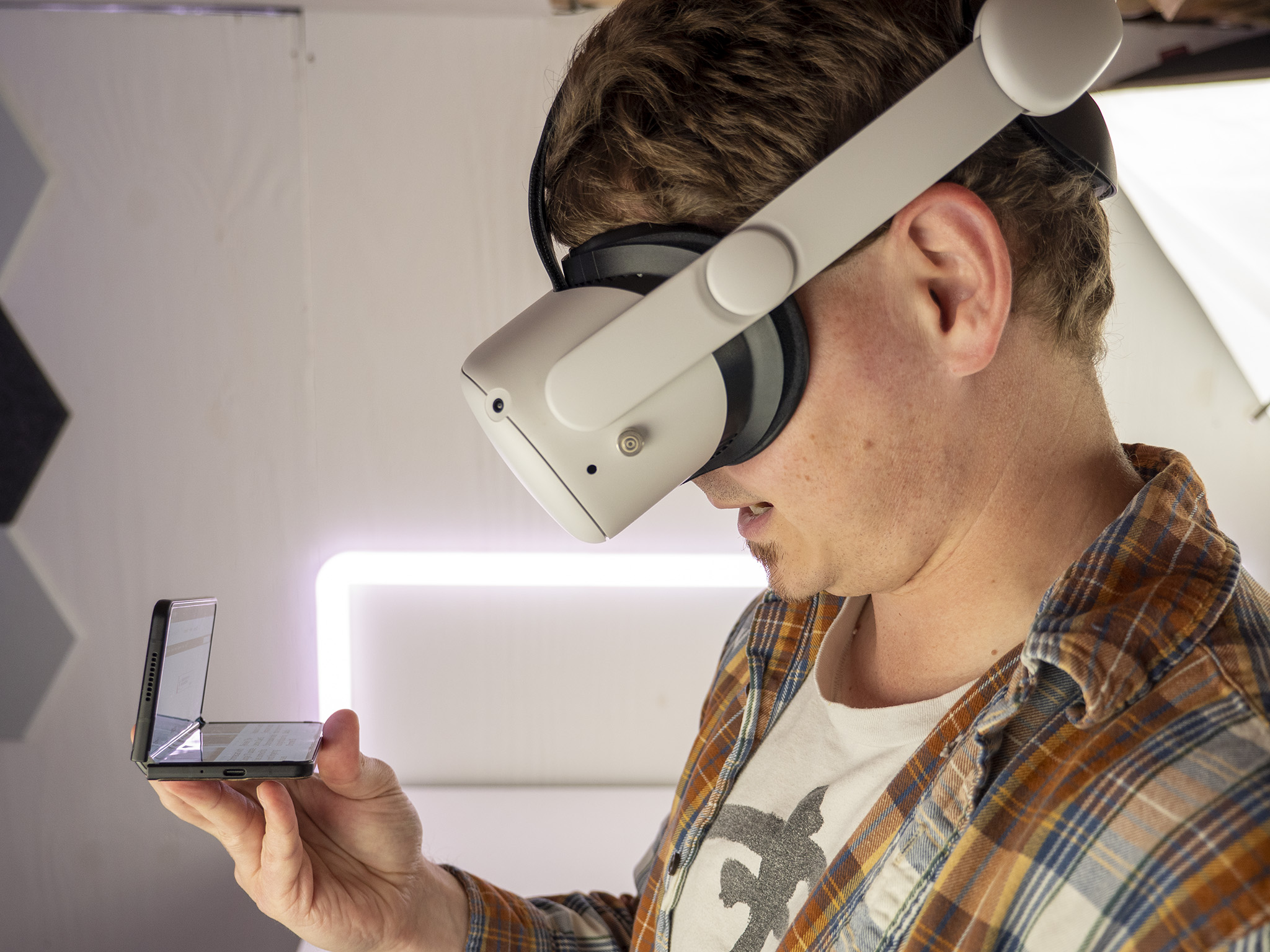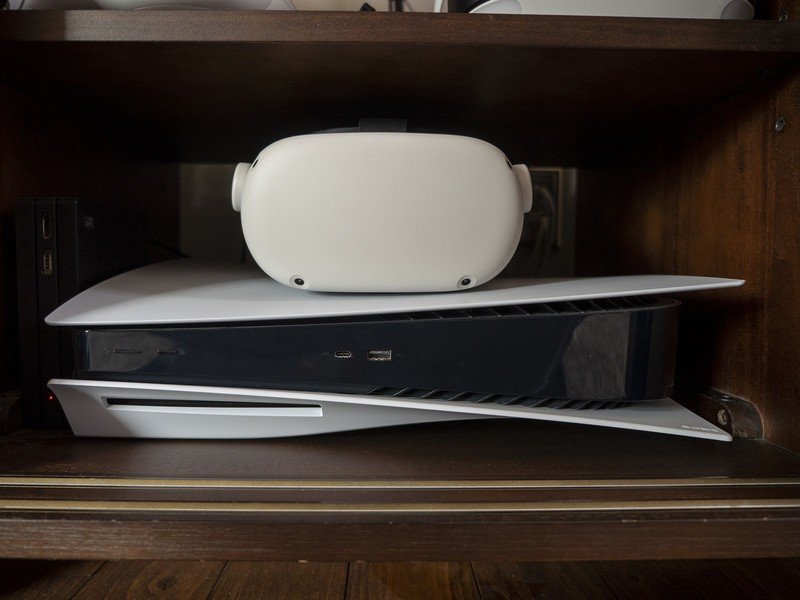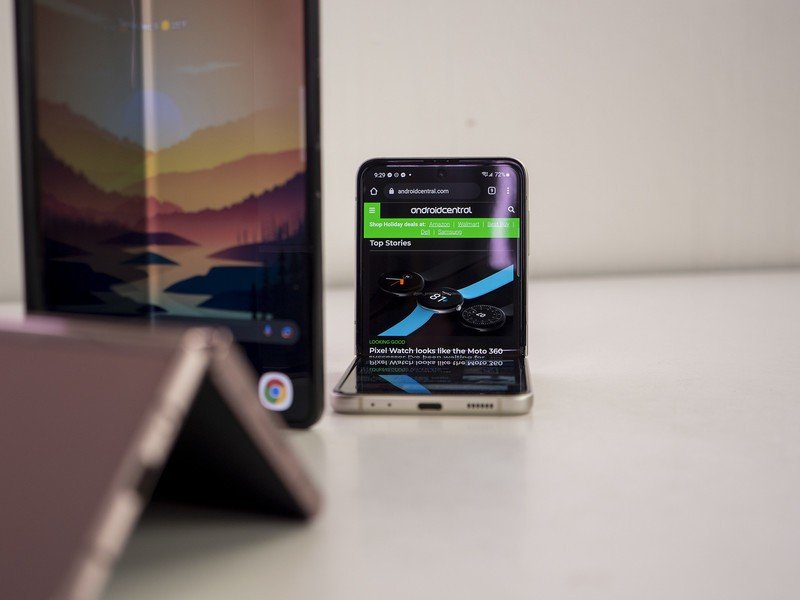The Galaxy Z Flip 3 and Oculus Quest 2's success prove we're ready for something new

When was the last time you truly got excited about buying a new smartphone? How about any of the new video game consoles like the PS5 or Xbox Series X|S? In many ways, it feels like these technologies have stagnated a bit, and most mainstream devices in these categories are quite boring when compared to the years and decades of fast and furious innovation we grew accustomed to.
But two products, in particular, are changing expectations for many people. It wasn't until the Samsung Galaxy Z Flip 3 and the Oculus Quest 2 that both foldables and VR really began to hit their stride.
VR and foldable phones don't have much in common on the surface, but it has become abundantly clear that these two technologies are winning over the hearts of consumers that brave the less traveled path and try newer types of tech.
In both cases, these technologies have been around for some time. Foldable concepts have been around since CES 2013 when Samsung showed off its first foldable displays, and VR has been around since the 80s in some way, shape, or form.
Both Meta and Samsung have set lofty sales goals to appease investors — that's 10 million units sold in a single year — and while only one of these products has actually achieved that goal thus far, both have made a major cultural impact, pioneering a road ahead that future products will follow.
The road to 10 million

This Holiday season, it's not just PlayStation vs Xbox numbers you should be looking at. It's Quest 2 versus PS5 and Xbox.
By all accounts, Meta has sold roughly 2 million more Quest 2's than Microsoft has Xbox Series X|S combined — 10 million vs. 8 million. It falls a few million short of the 13.4 million PS5 systems sold thus far, but given the Quest 2 was the #1-selling product during Black Friday, it may have closed the gap somewhat. That's a real win not just for Meta, but for the VR industry as a whole.
Get the latest news from Android Central, your trusted companion in the world of Android
By all accounts, Meta has sold roughly 2 million more Quest 2's than Microsoft has Xbox Series X|S combined.
Likewise, the Galaxy Z Flip 3 might not be selling in numbers as high as the Galaxy S21, but it's one of the only types of phones that Samsung is selling more of than it has in the past. It's a positive trend that shows consumer interest in new products that redefine expectations.
In fact, you might be surprised to find out that both of these products, ironically, are second-generation devices that launched roughly 18 months after the debut of the first of their kind. While Samsung used the number 3 in the name, the Z Flip 3 is really the second-generation Z Flip phone, as the Z Flip 5G was just a refresh of the original, released just a few months after the Z Flip debuted and featuring the same design as the original.
The Z Flip 3 debuted 18 months after the original — that's February 2020 to August 2021. The Quest 2 was the same, launching in October 2020, just shy of 18 months after the original Oculus Quest, which launched in May 2019.
In this relatively short timeframe, both Samsung and Meta have refined the user experience and hardware design in significant ways, from more ergonomic designs to more powerful chipsets, more resilient and comfortable hardware, and better software design, as well.
Anshel Sag, a senior analyst at Moor Insights & Strategy, says "with the Quest 2 I believe we they hit the right price target and ease of use and had the right chip to enable many of the features that were necessary for its success. The Flip3 is also a very similar story in that the refinements to the display and improved SoC and far more accessible price point."
VR and foldable devices were technologies that consumers have been excited about. They just needed the right product to make sense of new tech.
It's strangely common for a breakout product line to launch two years after a new tech product makes its debut. The Apple Watch debuted roughly two years after Samsung's first Galaxy Gear watch. The first Samsung Galaxy S didn't make an appearance until two years after Android launched.
Usually first-gen products catch consumers' eyes because of their great potential. You could make a compelling argument for choosing the Quest over a PC VR headset, or a Z Flip over a boring old smartphone. But in either case, you had some key missing components and frustrating flaws that squandered their potential a bit.
It's clear from this year's adoption rates that mainstream consumers are excited to adopt VR and foldable devices en masse. We didn't see more success out of the gate due to the flawed products available before now. Consumers were waiting for the right product before taking a chance on something new.
Jitesh Ubrani, IDC's research manager of worldwide device trackers, says "Based on our research, the Quest 2 will have shipped 10M units from its launch until the end of 2021. By contrast, we tracked about 1.5M Quest (original) over the lifetime of that product so Meta has certainly done quite well in raising awareness and interest in VR, and in 2021Q3, the company managed to capture 77% of the global VR headset shipments."
Appealing to a wider audience

When the first HTC Vive and Oculus Rift headsets debuted in 2016, they were focused solely on the hardcore PC gamer who was willing to spend a ton of money to get the most immersive experience possible. With the launch of the Quest at $399 — and the Quest 2 at just $299 — Meta undercut the competition by several hundred dollars while, at the same time, providing a superior experience in most ways.
Part of the Quest 2's success is because Meta has capitalized on working out at home.
But it's not just the right price that has made the Quest 2 a success where other VR headsets have failed commercially. It's also the content.
Ubrani points out that "VR had typically skewed towards a younger and more gaming-friendly audience but with apps like Supernatural and the numerous music/film experiences that have been made available on the Quest 2, Meta has been able to garner the interest of a much wider audience."
If you've driven around any major city or watched TV shows with commercials over the last year, you've almost assuredly seen at least one billboard or TV commercial featuring the Quest 2, and many of the ads that Meta runs for the Quest 2 are focused on the headset's ability to deliver a more interesting at-home workout than people normally experience.
But that focus on fitness doesn't mean that Meta has ignored the gamers that built the core of the VR audience for so many years. A quick gander at the best Quest 2 games list proves that Meta has been cultivating a stellar gaming experience along the way, even if they've made several slip-ups in that same timeframe.
Likewise, Samsung might have begun its foldables journey by appealing to the tech-savvy folks who only want the most cutting-edge devices in their pockets, but that quickly changed with the launch of the Galaxy Z Flip 3. Not only did Samsung drastically lower the price of its clamshell foldables — the original Z Flip sold for $1,450 while the Z Flip 3 sells for $999 — but they pivoted their marketing to change the perspective on clamshell phones.
I can't tell you how many times someone has seen my Z Fold 3 or my wife's Z Flip 3 and marveled at the fact that you can fold a phone in half.
It's not just a return to a classic form-factor; it's retro-chic in all the right ways and it appeals widely to young consumers in a way that devices haven't for some time. Ubrani agrees and further states that "the lower price point and aggressive bundling or trade-in offers have helped propel the Z Flip 3 and Samsung has also positioned the device as a piece of fashion which will pique the interest of certain buyers."
I can't tell you how many times someone has seen my Z Fold 3 or my wife's Z Flip 3 and marveled at the fact that you can fold a phone in half. It's new. It's exciting. It's exactly what phones needed to differentiate themselves again.
Dominating the supply chain

Few stories in 2021 have made headlines as often as the supply chain issues the world is experiencing. From food to technology and everything in-between, it's more difficult to obtain the materials needed to build practically anything and, even when you can procure the necessary materials, they're more expensive than they used to be. One trip to the grocery store confirms this.
Samsung and Meta have flipped supply chains in their favor, producing more units at lower prices than ever before.
Yet, Meta and Samsung have figured out ways around this, as they're not only building more units of their latest devices than ever before but are offering them at lower and lower prices than we've yet seen.
While the original Oculus Quest was horrendously difficult to find throughout the entirety of the 17 months it was on store shelves, the Meta Quest 2 has almost never had this problem. In fact, if you walk into any Best Buy, Walmart, Target, or GameStop, you'll likely be greeted to a scene similar to the one captured in this photo from @TheeBeardedBard on Twitter:
One Best Buy 833 Oculus Quests…of that isn’t an indication of how they are selling I don’t know what is…Small Town BTW. pic.twitter.com/wy1Tvv4A2hOne Best Buy 833 Oculus Quests…of that isn’t an indication of how they are selling I don’t know what is…Small Town BTW. pic.twitter.com/wy1Tvv4A2h— Theebeardedbard (@TheeBeardedBard) December 6, 2021December 6, 2021
Similarly, you'll have no trouble finding a Galaxy Z Flip 3 anywhere that normally carries smartphones, despite incredibly aggressive sales and trade-in promotions designed to get more customers on board with foldables. Samsung hasn't had quite as long to convince customers that the Z Flip 3 is the device they want as Meta has with the Quest 2, but it's on track to see the same level of success a year from now when the Z Flip 4 launches.
Ubrani confirms this and states that "our estimates suggest that the first generation shipped just over a million units over its lifetime while the Z Flip 3 has shipped close to 2M in just one quarter (2021Q3) so sales of the latest generation are certainly off to a great start."
That's certainly a similar trajectory to what we've seen with the Quest 2 versus the original Oculus Quest, and it shows that consumers are ready for something new and exciting. It's great for industry niches that have seen some difficulties in conveying the advantages that these new technologies can deliver, and it also shows that slow and steady wins the race.
Most successes don't happen overnight. Slow and steady wins the race.
After all, most successes don't happen overnight. This applies to people as much as to products, and it's often the ones that fail the most throughout their journey that find ultimate success. Here's to the next 10 years of innovation from both the VR and foldables segments which will, no doubt, continue to blow our minds for years to come.

